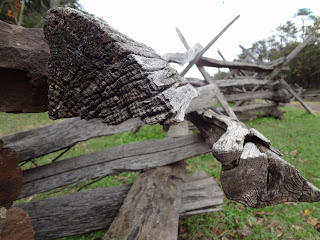 |
| The battlefields and cannons |
I found myself wandering the fields of Manassas Battlefields, which I admit is one of my favorite places in Northern Virginia. Then again, I am a huge history buff so I assume this is only natural.
The battlefield is home to two battles, the first battle of Manassas, taking place on July 21, 1861 and then later the Second battle of Manassas during Aug 28-30th 1862. While a good portion of the land has been taken over by businesses, a local community college and homes-including the houses I grew up in, a good portion of it still remains in the hands of the park authorities, despite the few attempts to buy it back and sell it, to this day it remains open to the public.
And on this cool Autumn afternoon, I took full advantage of the low crowds, and the gorgeous fall colors and explored the treasures in my own backyard.
The Stone House
 |
| The Stone House, taken over and used as hospital. |
Once the war hit, the Matthews tried to remain in the house but soon found themselves in the midst of the battle, and the house was shortly taken over by Union soldiers and used as a place for wounded and the dying. When the fighting finally ended, the southerners came back to the house to find 100 weapons and “a large number of the wounded enemy, some dead, and thirty-six men, who surrendered themselves prisoners.” Among the prisoners were two Union medical officers, a surgeon and an assistant surgeon. Only the assistant surgeon was allowed to remain and care for the many sufferers as best he could. No evidence exists that any surgical operations took place inside the house.
 During the second battle, the defeated Union soldiers passed the Stone house, Private George Edgcomb of the 23rd New York entered the house on the 30th of August to aide an injured soldier, when he entered he came across two additional wounded men. Somehow they had made their way up to the usually unoccupied second floor, where two small rooms were. There they carved their initials in the floorboard, which can still be seen to this day.
During the second battle, the defeated Union soldiers passed the Stone house, Private George Edgcomb of the 23rd New York entered the house on the 30th of August to aide an injured soldier, when he entered he came across two additional wounded men. Somehow they had made their way up to the usually unoccupied second floor, where two small rooms were. There they carved their initials in the floorboard, which can still be seen to this day. “E.P. Ge” and “Brehm Aug 30.” Which stood for Charles Brehm and Eugene Geer, Brehm would later recover from his wounds, and Eugene died there at the house. He was 17.
“E.P. Ge” and “Brehm Aug 30.” Which stood for Charles Brehm and Eugene Geer, Brehm would later recover from his wounds, and Eugene died there at the house. He was 17.While it isn't often, they still open the house for tours from time to time, and it isn't a shock to see a red tethered flag waving from the door, which indicated to the soldiers it was safe to come in.
Wooden Fences
 |
| Intact wood fencing. |
 |
| Confederate cannons |
Civil War Cannons
In the middle of the baddlefields lies 40 cannons from both the Union and the Confederate. Stationed right before the First Manassas trial, several confederate cannons are lined, stationed and ready to go. Many of the cannons, on both side still have the original parts connected to them. Though not in use very often any more some can be used for demonstrations, anniversary's and special occasions to this this day.
One can tell the difference in the cannons, by the color of the cannons, and the look. The confederate cannon for instance have a green tent to them and are made of copper. The bodies of the cannons, are thicker and shorter than those of their enemies.
 |
| Union cannons |
These were some of the first weapons used in the early stages of the Civil War.
Stonewall Jackson
 |
| Stonewall Jackson Monument |
'There stood Thomas Jackson, looking like a stone wall.'
Amongst the Confederates, Thomas Jackson found himself in the midst of battle against the Union. Disgusted by the way the Union fought he watched in stillness against enemy lines. As the confederate soldiers moved ahead against the Union Thomas 'Stonewall' Jackson stood alongside his fellow Virginians. The day before the land was peaceful, quiet and farmland now he watched in horror as those same lands became a bloody battlefield, and by the time nightfall came over 900 soldiers had lost their lives.
The Henry House
Just as the Stone house found itself in the midst of the war, so did the Henry House. Jackson took up position on the family hill having no clue that the family, an 85 year old widow Judith Henry and her two grown sons still remained. Ms. Henry who was bedridden and not able to flee slept in her upstairs bedroom as the battle raged on. The morning of July 21st, a Union cannon flew through the bedroom wall, tearing off one of her feet, and inflicting several other injuries. Henry would die later that day from her wounds. She would be the only bystander causality of the battle.
The incident was memorialized by the movie North and South in 1985.
While both battles may not be as historically known as the likes of Gettysburg and other battles, nearly 5,000 soldiers lost their lives between both battles and is still known as the battle to begin the brother wars.


No comments:
Post a Comment